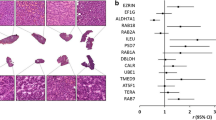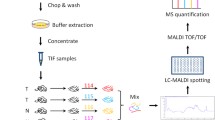Abstract
Hepatocellular carcinoma (HCC) is one of the most common malignancies in the world, and there is an urgent need to discover novel factors that can act as biomarkers for prognostic assessment and therapeutic targets of HCC. In this study, highly purified plasma membrane proteins from clinical tissue samples were obtained using a strategy combining sucrose density gradient centrifugation and subsequent phase partition. Using a two-dimensional gel electrophoresis and MALDI-Q-TOF MS/MS-based proteomics approach, we identified 13 plasma membrane-associated proteins that were differentially expressed in HCC and normal liver tissues. Of those, RhoA was one of the most significantly upregulated proteins in HCC, and its overexpression was confirmed using Western blotting. Immunohistochemistry suggested a link between RhoA expression and poor differentiation and clinicopathologic stage. Suppression of RhoA expression in HepG2 and Hep3B cells by RNA interference led to significant inhibition of cell growth, induction of apoptosis, and a decrease in migration. Our data suggest that RhoA may serve as a potential biomarker and an attractive therapeutic target for HCC.







Similar content being viewed by others
References
El-Serag HB, Mason AC (1999) Rising incidence of hepatocellular carcinoma in the United States. N Engl J Med 340:745–750
Skolnick AA (1996) Armed with epidemiologic research, China launches programs to prevent liver cancer. J Am Med Assoc 276:1458–1459
Levin B, Amos C (1995) Therapy of unresectable hepatocellular carcinoma. N Engl J Med 332:1294–1296
Bruix J, Llovet JM (2002) Prognostic prediction and treatment strategy in hepatocellular carcinoma. Hepatology 35:519–524
Kim KR, Moon HE, Kim KW (2002) Hypoxia-induced angiogenesis in human hepatocellular carcinoma. J Mol Med 80:703–714
Aravalli RN, Steer CJ, Cressman EN (2008) Molecular mechanisms of hepatocellular carcinoma. Hepatology 48:2047–2063
Branda M, Wands JR (2006) Signal transduction cascades and hepatitis B and C related hepatocellular carcinoma. Hepatology 43:891–902
Sutton A, Nahon P, Pessayre D, Rufat P, Poiré A, Ziol M, Vidaud D, Barget N, Ganne-Carrié N, Charnaux N et al (2006) Genetic polymorphisms in antioxidant enzymes modulate hepatic iron accumulation and hepatocellular carcinoma development in patients with alcohol-induced cirrhosis. Cancer Res 66:2844–2852
Du XL, Hu H, Lin DC, Xia SH, Shen XM, Zhang Y, Luo ML, Feng YB, Cai Y, Xu X et al (2007) Proteomic profiling of proteins dysregulated in Chinese esophageal squamous cell carcinoma. J Mol Med 85:863–875
Cravatt BF, Simon GM, Yates JR 3rd (2007) The biological impact of mass-spectrometry-based proteomics. Nature 450:991–1000
Kondo T, Hirohashi S (2006) Application of highly sensitive fluorescent dyes (CyDye DIGE Fluor saturation dyes) to laser microdissection and two-dimensional difference gel electrophoresis (2D-DIGE) for cancer proteomics. Nat Protoc 1:2940–2956
Shields DJ, Niessen S, Murphy EA, Mielgo A, Desgrosellier JS, Lau SK, Barnes LA, Lesperance J, Bouvet M, Tarin D et al (2010) RBBP9: a tumor-associated serine hydrolase activity required for pancreatic neoplasia. Proc Natl Acad Sci USA 107:2189–2194
Wang L, Zhu YF, Guo XJ, Huo R, Ma X, Lin M, Zhou ZM, Sha JH (2005) A two-dimensional electrophoresis reference map of human ovary. J Mol Med 83:812–821
Han MH, Hwang SI, Roy DB, Lundgren DH, Price JV, Ousman SS, Fernald GH, Gerlitz B, Robinson WH, Baranzini SE et al (2008) Proteomic analysis of active multiple sclerosis lesions reveals therapeutic targets. Nature 451:1076–1081
Zhou J, Zhou T, Cao R, Liu Z, Shen J, Chen P, Wang X, Liang S (2006) Evaluation of the application of sodium deoxycholate to proteomic analysis of rat hippocampal plasma membrane. J Proteome Res 5:2547–2553
Jayanthi LD, Samuvel DJ, Ramamoorthy S (2004) Regulated internalization and phosphorylation of the native norepinephrine transporter in response to phorbol esters. Evidence for localization in lipid rafts and lipid raft-mediated internalization. J Biol Chem 279:19315–19326
Chignard N, Beretta L (2004) Proteomics for hepatocellular carcinoma marker discovery. Gastroenterology 127:S120–S125
Seow TK, Liang RC, Leow CK, Chung MC (2001) Hepatocellular carcinoma: from bedside to proteomics. Proteomics 1:1249–1263
Cao R, Li X, Liu Z, Peng X, Hu W, Wang X, Chen P, Xie J, Liang S (2006) Integration of a two-phase partition method into proteomics research on rat liver plasma membrane proteins. J Proteome Res 5:634–642
Norling B, Zak E, Andersson B, Pakrasi H (1998) 2D-isolation of pure plasma and thylakoid membranes from the cyanobacterium Synechocystis sp. PCC 6803. FEBS Lett 436:189–192
Peirce MJ, Wait R, Begum S, Saklatvala J, Cope AP (2004) Expression profiling of lymphocyte plasma membrane proteins. Mol Cell Proteomics 3:56–65
Perkins DN, Pappin DJ, Creasy DM, Cottrell JS (1999) Probability-based protein identification by searching sequence databases using mass spectrometry data. Electrophoresis 20:3551–3567
Kreisberg JI, Malik SN, Prihoda TJ, Bedolla RG, Troyer DA, Kreisberg S, Ghosh PM (2004) Phosphorylation of Akt (Ser473) is an excellent predictor of poor clinical outcome in prostate cancer. Cancer Res 64:5232–5236
Finlayson AE, Freeman KW (2009) A cell motility screen reveals role for MARCKS-related protein in adherens junction formation and tumorigenesis. PLoS One 4:e7833
Lajoie P, Goetz JG, Dennis JW, Nabi IR (2009) Lattices, rafts, and scaffolds: domain regulation of receptor signaling at the plasma membrane. J Cell Biol 185:381–385
Maxfield FR (2002) Plasma membrane microdomains. Curr Opin Cell Biol 14:483–487
McNiven MA, Thompson HM (2006) Vesicle formation at the plasma membrane and trans-Golgi network: the same but different. Science 313:1591–1594
Saraste J, Goud B (2007) Functional symmetry of endomembranes. Mol Biol Cell 18:1430–1436
Olson MF, Ashworth A, Hall A (1995) An essential role for Rho, Rac, and Cdc42 GTPases in cell cycle progression through G1. Science 269:1270–1272
Wei Y, Zhang Y, Derewenda U, Liu X, Minor W, Nakamoto RK, Somlyo AV, Somlyo AP, Derewenda ZS (1997) Crystal structure of RhoA-GDP and its functional implications. Nat Struct Biol 4:699–703
Chan CH, Lee SW, Li CF, Wang J, Yang WL, Wu CY, Wu J, Nakayama KI, Kang HY, Huang HY et al (2010) Deciphering the transcriptional complex critical for RhoA gene expression and cancer metastasis. Nat Cell Biol 12:457–467
Hoshino D, Tomari T, Nagano M, Koshikawa N, Seiki M (2009) A novel protein associated with membrane-type 1 matrix metalloproteinase binds p27(kip1) and regulates RhoA activation, actin remodeling, and matrigel invasion. J Biol Chem 284:27315–27326
Suzuki C, Daigo Y, Ishikawa N, Kato T, Hayama S, Ito T, Tsuchiya E, Nakamura Y (2005) ANLN plays a critical role in human lung carcinogenesis through the activation of RHOA and by involvement in the phosphoinositide 3-kinase/AKT pathway. Cancer Res 65:11314–11325
Zhao X, Lu L, Pokhriyal N, Ma H, Duan L, Lin S, Jafari N, Band H, Band V (2009) Overexpression of RhoA induces preneoplastic transformation of primary mammary epithelial cells. Cancer Res 69:483–491
Acknowledgments
This study was supported by the National Natural Science Foundation of China (No. 30872742).
Disclosure of potential conflict of interests
The authors declare no conflict of interests related to this study.
Author information
Authors and Affiliations
Corresponding author
Rights and permissions
About this article
Cite this article
Gou, L., Wang, W., Tong, A. et al. Proteomic identification of RhoA as a potential biomarker for proliferation and metastasis in hepatocellular carcinoma. J Mol Med 89, 817–827 (2011). https://doi.org/10.1007/s00109-011-0753-3
Received:
Revised:
Accepted:
Published:
Issue Date:
DOI: https://doi.org/10.1007/s00109-011-0753-3




